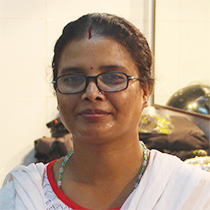the saga of enchanting beauty in stones

13 Fabruary, 2019 (National Women's Day)
Today we know this legendry beauty as ‘Didarganj Chauri Bearer Female Figure’ or ‘Didarganj Yakshini’, exhibited in Patna Museum, Patna. This is the first life-size three diemnsional female statue sculpted on Indian archaeological time line, as early as in 3rd century BC. The icon, reagarded as a jewel of artefacts, has decorated the National Museum, New Delhi, for some time in 80’s and travelled across a dozens of countries during Festival of India.
The play YAKSHINI, the first production in the series of Heritage Infodrama, is based on this iconic figure.
The play has been regarded as the first theatrical creation in the subject of public museology or museum education by eminent scholars and institutions of India.
According to archaeologists, historians and art historians, the Didarganj Chauri Bearer is, most probably, depiction of 'complete womanhood' or 'goddess of fertility'.
Obviously, it was sculpted as a tribute to the womankind in 3rd century BC; and, the play YAKSHINI based on it, is a tribute to womankind in 21st century AD!
The play showcases the followings:
- The documented story of the excavation of “Didarganj Yakshini” and its accession to Patna Museum in 1917 including the details of intervening events.
- The historical, aesthetic and archaeological 'features & facts' related to this figure.
- A fictitious story within the limits of historical facts describing the possible objective and circumstance of sculpting of this masterpiece in 3rd century BC.
- The "cult value" of this figure for the rural folk who found this statue (a goddess?), as well as the "exhibition value" of the figure for the gentry who received this figure in to the newly built Patna Museum (depiction of complete womanhood?).
"Love and respect for cultural heritage is characteristic of a civilized and intellectually developed society".
Knowledge of Cultural Heritages and Traditions gives 'self-identity' and 'self-respect', which are the key-elements responsible for progress of an individual, and hence, of society. Therefore, people must know well about their cultural heritages, viz., archaeological discoveries, monuments, artefacts, antiquities, great personalities etc., and they must be aware of the importance of conservation and maintainance of the same.
Therefore, people must be informed and educated about the cultural heritages and their importance through poupular media, because a common man has not enough time and willingness to read books and research-papers. This is why Sunita Bharti has launched the series of Heritage Plays, keeping in mind the fact that a theatrical-presesntation has deeper impact on the public conscience than video and cinema.
The play Yakshini, and each of the forthcoming plays of the series Heritage Play, has been exclusively created and designed with the help of experts and authorities of the subject for educating people about the amazing past of our land and culture. At the same time, such a production creates awareness for conservation of cultural heritages. In fact, the same is the objective of 'museum-education or 'public museology’ taught in the syllabus of 'museological studies', hence, the play Yakshini is regarded as the 'first theatrical presentation in public museology'.
The play Yakshini is suitable for both the stages, proscenium and amphi-theatre. It uses modern stage-crafts and techniques for its diverse scenes.
Since many characters in the play are real historical persons, well documented in the annals, the costume, dialogues and body language of artists require much attention and precision. A few characters are fictitious but created as supplementary characters to illustrate the historical context lively, therefore they too must be traeted as real characters and require precision in their characterizarion on stage.
The play complies with the popular theatrical norms, has dramatic fluidity, and provides a wide scope for creative and technical applications to the director, actors and the back-stage artists.
The play consists of two acts.
Act-one displays the story of its excavation and retrieval, based on the documented facts with all real characters of the episode of 1917. All the physical, historic, aesthetic, and archaeological features of this icon have been explained through the dialogues of the characters in a very interesting manner so that the audience learn and grasp every information related to this figure while entertaining themselves.
The play specifically highlights the 'public interpretation' of this artwork at the time sculpture was discovered. According to historian Richard H. Davis, there is always a “cult value” of images in a particular culture or community. But Dr. D. B. Spooner, who played an important role in accession of the image to the Patna Museum, and wrote a report on Didarganj Image in the Journal of Bihar and Orissa Research Society in 1919, considered only the “exhibition value” of the icon; and he didn't enquire what the locals opined about the image. If they were worshiping the icon, what did they think of this icon? In act-one of this play, the writer has made a logical conjecture of what the villagers would have thought of this image, based on traditional belief and cult-practices.
Act-two of the play shows a fictitious story portraying a sculptor, a model and the circumstances leading to the sculpting of this masterpiece in 3rd century BC; within the limits of the historical facts, in order to make alive the era in which the icon was created. This story aids to the creative imagination of audience to realize the period in which this sculpture was created and at the same time it connects the audience with this icon emotionally.
Apart from Yakshini, the pioneer work in public museology, some other plays in the Heritage Infodrama Series is being prepared based on important and famous museum collections, archaeological excavations and ancient great personalities; uncovering some unknown chapters of Indian culture and tradition of philosophical and scientific ideas developed in the different epochs of time. Each of the play in the series deals with the information related to the central subject in form of an interesting story fabricated within the boundary of historical and archaeological facts.
These plays, based on extensive academic research and exploration opens up a new vista in Indian theatre : the Utiliterian Theatre or InfoDrama - a step towards the industrialization of Indian Theatre.

In my opinion, the outcome of dedicated labour and talent of our archaeologists and historians in reconstructing our past, must not be confined within a circle of intellectual minority; but must reach every nook and corner of society. Therefore, the existence of archaeological 'artefacts' and 'discoveries' must resonate in the conscience of common people surpassing the walls of the museums. If it so happens, our heritage could be preserved in the hearts of people beyond the confines of 'museums' and 'sites'.
Therefore, with an objective to bring the stories of archaeological discoveries on public platform out of museums; and being inspired by the popular remark of Greek philosopher Cicero, “To be ignorant of the past is to be forever a child”, I steered my passion, the theatre, to a more utilitarian path and started a series of Heritage Plays. Plays of this series show the stories of archaeological discoveries and highlight the related information to make people aware of the museum-collections and other heritages. The play Yakshini, based on the Mauryan sculpture ‘the Didarganj Chawry Bearer’ excavated in 1917, is the first production of this series.
This is a fact that message and information delivered through plays have deeper impact on public-conscience compared to cinema and videos. It was the most thrilling moment in my theatre career when a humble audience, after the first show of Yakshini greeted me with remark, "we used to go to museum, you have brought museum to us". Perhaps, this was the greatest reward I ever had in my life for my humble works.
We know that the role of museums is not limited to collecting and conserving things but also to educate people about them. In this respect, Yakshini is the first theatrical piece in the subject of Public Museology. Staging of such plays in Museums, Universities and other organizations of similar nature will certainty create a positive atmosphere for propagation, protection and conservation of our heritage and culture, because more we know about antiquities, more we love and respect them and more are we keen for their conservation.
I hope people will welcome the upcoming play of this series 'Ashthi Kalash', which is based on the excavation of the relics of Buddha at Vaishali in 1958, with the same love and enthusiasm as they have greeted its predecessor Yakshini.
Thanks!
Act - 1
-
Bulakani: The washerwoman (of the village Tajpur-Rasulpur, Didarganj Kadam Rasul, where the icon was found) who cleans the cloth on the protruding pedestal of the underground chowry-bearer in 1917. (Played by Sunita Bharti)
-
Aklu, Rhman, Janki, Dashain and Badaruddin: Labourers (of the aforesaid village) who were in digging of the chowry-bearer out of earth. The names are imaginary.
-
Bhunesar Pande: Hindu priest of the aforesaid village. Name is imaginary.
-
Narendra: Student of Patna college hailing from the aforesaid village who informed Professor Samadar about the find; a historical caharacter mentioned by Spooner (name is imaginary).
-
Gulam Rasul: Son of Kaji of the aforesaid village, a historical character mentioned in the report of Dr. Spooner and in the confidential report of the inspector of Malsalami thana, Patna dated 20 October 1917.
-
Prof. J. N. Samadar: Professor of Patna College, the renowned historian and author.
-
E. H. C. Walsh: Member of the Board of Revenue and the president of Patna Museum Committee in 1917.
-
Dr. D. B. Spooner: The renowned American Archaeologist & Superintendent, Archaeological Dept. Eastern Circle.
-
Inspector of Malsalami Thana: Real Character
-
Other Villgers
-
Orderly of Wlsh
Act - 2
-
Devi Madhavi: A royal girl of Sravasti, secretly married with Magadh Emperor; the model and inspiration for the sculpting of the Chowry-Bearer.
-
Raj-Shilpi Bhadrak: State Sculptor of Magadha, enamoured one sidedly with Madhavi.
-
Mahanaman: A retired captain of Mgadha, caretaker of Madhavi.
-
Amatya Harshdev: Amatya (Minister) of Magadha.
-
Mhanayak Jayraj: Mhanayak (General) of Magadhan army.
-
Vyom: Helping hand of Bhadrak
-
Radha: Maid employed by Bhadrak for Madhavi, par amour of Vyom.
-
Yuvraj: Heir presumptive of Magadhan Throne.
-
Laghunak and Chhapanak: Spies of Yuvraj.
-
Orderly of Amatya
-
Soldiers











































